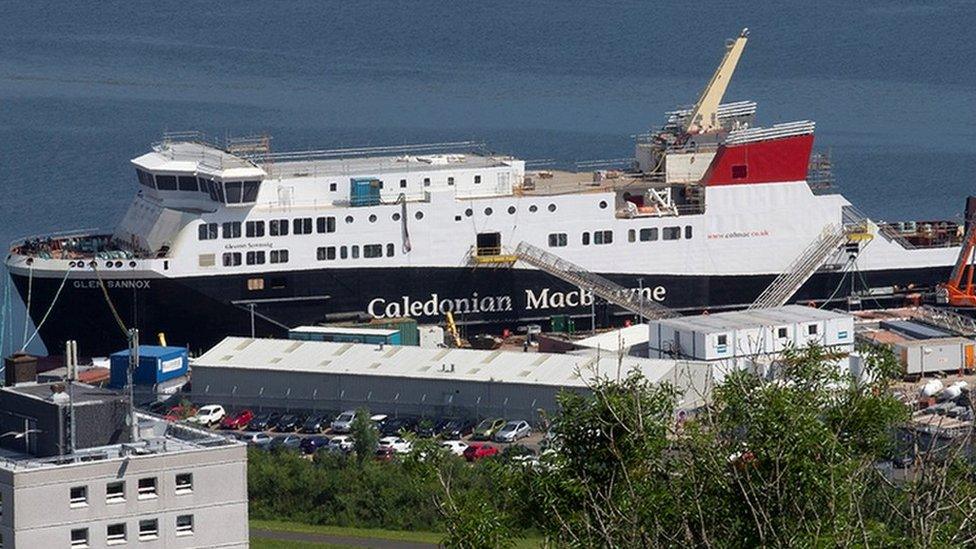Delivery date for overdue ferries slips again
- Published

The structure of Glen Sannox including the funnel is now complete
The delivery date for two ferries being built for CalMac at the nationalised Ferguson shipyard has slipped again.
The first ship Glen Sannox will now be handed over between July and September next year - 15 weeks later than expected.
The nationalised shipyard said Covid disruption and a shortage of local skilled labour were to blame.
Glen Sannox, destined for the Arran route, was originally due to enter service in 2018/19.
The second ship, currently known as Hull 802, will be delivered between April and July 2023, according to the latest schedule.
The ship is due to operate on the Skye/Outer Hebrides routes.
The yard introduced a weekend shift in March, hoping to make up time that was lost during two shutdowns that took place during the Covid pandemic.
However, in an update to MSPs, it said it had only been able to recruit 40 skilled workers locally, 100 short of its target - and was now having to recruit overseas workers, via sub-contractors.
Some fabrication is also now being sub-contracted to other Scottish firms.

Glen Sannox is now due to be delivered between July and September next year
Despite the new 15-week delay for both vessels, Ferguson Marine said good progress was being made, including remedial paintwork and the completion of the main structural work on Glen Sannox.
Tim Hair, the turnaround director appointed by the Scottish government, said: "I know the further delay to the project will be a disappointment to island communities and others who await the arrival of the new ferries.
"There remains a lot of work to do on the vessels, but it is important to recognise the level of progress too, as well as the significant operational improvements we have implemented to introduce robust and effective business processes.
"We have, in effect, created a functioning shipyard business from a standing start."

How the costs have added up
£97m - original fixed price contract for design and construction
£110m-£114m - estimated cost of "remedial work" to finish the ships after the yard was nationalised
£45m - Scottish government loans to Ferguson prior to its collapse, which are now "written down", an assumption they will not be fully repaid
£4.3m - "exceptional costs" as a result of two yard shutdowns during the Covid pandemic

The Ferguson yard was owned by millionaire businessman Jim McColl when it won the contract to design and build the dual fuel ferries, which can use both diesel and liquefied natural gas.
Mr McColl had rescued the yard from going bust and invested heavily in refitting it, but the ferry order ultimately dragged the yard back into administration as costs soared and deadlines slipped.
Both sides blamed each other for the problems. Mr McColl accused CMAL, which procures ships for publicly-owned ferry firm CalMac, of making repeated specification changes while CMAL claimed the yard rushed ahead with construction before the design was ready.
The shipyard was nationalised by the Scottish government in December 2019.


It's taken since last August to get an update on the two ferries. Seven weeks' delay is explained by Covid, eight weeks by the shortage of skilled workers - and that's despite a pay hike and generous weekend overtime.
Several of those weeks are the result of social distancing rules. The "turnaround director" Tim Hair tells us that the shipyard canteen could not operate under those requirements, so the whole yard had to shut down in January.
He also tells us that the design, which kept changing prior to nationalisation, took a further 14 months to be frozen, only getting to that stage last autumn. That required 100 graduate engineers and a sub-contractor.
And still there's some risk attached to the specialist pipework required for liquified petroleum gas - these being dual-fuelled ships. It's still being manufactured.
The cost has gone up by more than £4m, which looks modest by comparison with the previous price hikes for these ships over the three years since they should have been providing a reliable Cal-Mac service for Arran, Skye, Harris and the Uists.
That extra spending, mainly on wages, is being absorbed by Ferguson shipyard, making it appear that costs are still nailed down.
But that adds to the shipyard's red ink. And as the Scottish government is owner of the shipyard, the client, CMAL, and the user of the ships, Cal-Mac, the bill comes back to the same address: St Andrew's House in Edinburgh.
So do the legal letters that may yet fly in, settling the disputes that caused the previous owners, led by the industrialist Jim McColl, to be put into administration.
